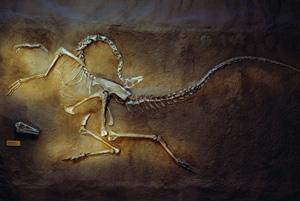@WFS,World Fossil Society,Riffin T Sajeev,Russel T sajeev
Recreating the spectacular pose many dinosaurs adopted in death might involve following the simplest of instructions: just add water.
When palaeontologists are lucky enough to find a complete dinosaur skeleton – whether it be a tiny Sinosauropteryxor an enormous Apatosaurus – there’s a good chance it will be found with its head thrown backwards and its tail arched upwards – technically known as the opisthotonic death pose. No one is entirely sure why this posture is so common, but Alicia Cutler and colleagues from Brigham Young University in Provo, Utah, think it all comes down to a dip in the wet stuff.
Cutler placed plucked chickens – both fresh and frozen – on a bed of sand for three months to see if desiccation would lead to muscle contractions that pulled the neck upwards – a previously suggested explanation for the death pose. The chickens decayed without contorting. When seven other chickens were placed into cool, fresh water, however, their necks arched and their heads were thrown back within seconds. Sustained immersion of the birds for up to a month slightly increased the severity of the pose, but the major movement of the head occurred almost immediately.
Cutler presented the findings at the Society of Vertebrate Paleontology conference in Las Vegas, Nevada, earlier this month.
Source: article by Brian Switek,New Scientist magazine
Key:@WFS,World Fossil Society,Riffin T Sajeev,Russel T sajeev



 October 2nd, 2016
October 2nd, 2016  Riffin
Riffin 
 Posted in
Posted in  Tags:
Tags: 